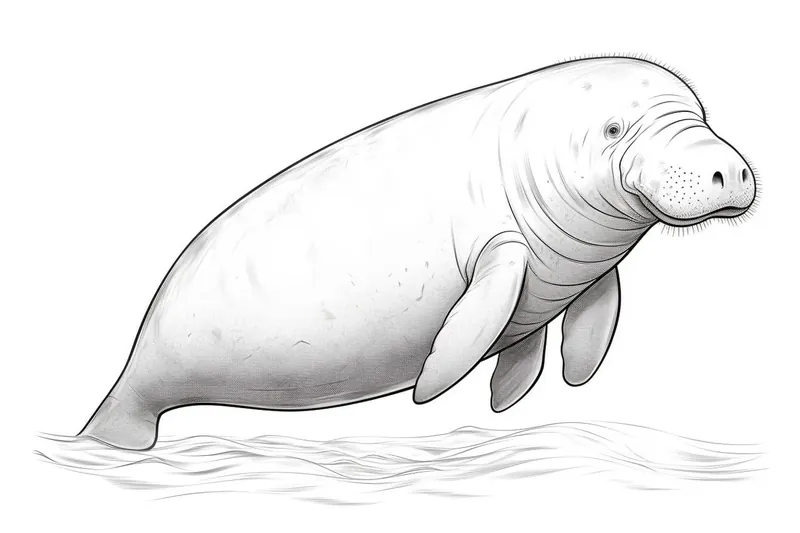How to Draw a Dugong
Learn how to draw a Dugong with ease in this step-by-step tutorial. Discover helpful tips and techniques to create a realistic and detailed Dugong drawing. Perfect for artists of all skill levels.

Materials You'll Need
- Pencil
- Paper
- Eraser
 Drawing a Dugong, often affectionately dubbed a "sea cow," offers artists a unique opportunity to engage with the beauty of this gentle marine mammal. With its robust, rounded body and charming flippers, the Dugong is not only an excellent subject for artistic expression but also a fascinating creature that captures the imagination of people around the world. Whether you're a newcomer to the world of drawing or a seasoned artist, depicting this serene underwater inhabitant can be both an enjoyable and enriching challenge.
Drawing a Dugong, often affectionately dubbed a "sea cow," offers artists a unique opportunity to engage with the beauty of this gentle marine mammal. With its robust, rounded body and charming flippers, the Dugong is not only an excellent subject for artistic expression but also a fascinating creature that captures the imagination of people around the world. Whether you're a newcomer to the world of drawing or a seasoned artist, depicting this serene underwater inhabitant can be both an enjoyable and enriching challenge.
As we embark on this artistic journey together, we will explore the key characteristics that define the Dugong and provide clear, step-by-step instructions to help you create a stunning representation. This guide is designed to cater to artists at all levels, empowering you to master the nuances of drawing while honing your skills in observing and replicating nature's delicate balance. So, prepare your drawing materials, unleash your creativity, and let's dive into the enchanting world of marine artistry, where the graceful Dugong awaits!
Materials Required
To draw a Dugong, you will need the following materials:
- [Drawing paper or sketchbook](https://yonderoo.com/best-sketchbooks-for-artists/)
- Pencils (preferably a range of graphite pencils from 2H to 6B for shading)
- Eraser (a kneaded eraser is ideal for lifting graphite without damaging the paper)
- Blending stump or tortillon for blending and shading
- Reference image of a Dugong for accuracy and inspiration
Optional materials:
- Colored pencils or markers for adding color to your drawing
- Fine liner pens for adding details and outlines
- Drawing board to keep your paper flat and steady
- Fixative spray to protect your finished drawing from smudging
With these materials:
How to Draw a Dugong: a Step-by-step Guide
Step 1: Gather Your Materials
Start by gathering the necessary materials for your drawing. You will need a pencil, eraser, drawing paper, and any coloring tools you may want to use later on.
Step 2: Reference Image
Find a clear reference image of a Dugong to use as a guide while drawing. This will help you understand the structure and proportions of the animal.
Step 3: Basic Outline
Begin by lightly sketching the basic shape of the Dugong using simple shapes like ovals and circles. Start with the body, head, and flippers.
Step 4: Adding Details
Once you have the basic outline in place, start adding details to your drawing. Focus on the unique features of the Dugong such as its flippers, tail, and the texture of its skin.
Step 5: Face and Eyes
Pay special attention to the Dugong's face and eyes as these features will give your drawing personality and expression. Add in the nostrils, mouth, and any other facial details.
Step 6: Finishing Touches
Refine the details of your drawing, making sure to capture the essence of the Dugong accurately. Add in any additional features like the patterns on its skin or any underwater elements to enhance the overall composition.
Step 7: Erase and Refine
Once you are satisfied with the overall look of your drawing, go over the lines with a darker pencil or pen. Erase any remaining guidelines and lightly sketch lines to add depth and dimension to your Dugong drawing.
Step 8: Coloring (Optional)
If you choose to color your drawing, use shades of gray and brown to mimic the Dugong's natural coloring. Pay attention to the lighting in your reference image to add shadows and highlights for a more realistic look.
Step 9: Final Touches
Take a step back and assess your drawing. Make any final adjustments or additions to ensure that your Dugong drawing is complete and visually appealing.
Step 10: Sign Your Work
Don't forget to sign your drawing to add a personal touch and mark it as your own creation. Step back and admire your completed Dugong drawing with pride!
Tip: When drawing a Dugong, focus on capturing its unique body shape and features through careful observation and layering techniques. Start with light pencil strokes to outline the rounded form, paying special attention to the gentle curve of its back and the broad, paddle-like flippers. Use a blending stump or your finger to softly smudge and shade the body, giving it a smooth, almost water-like texture that reflects its aquatic nature. For added depth, layer darker shades in the areas under the flippers and around the belly to create dimension. Finally, consider using colored pencils or watercolors to introduce subtle hues of gray and green, mimicking the Dugong's natural habitat. This approach will not only enhance the realism of your drawing but also make the creature feel alive on the page!
Conclusion
Congratulations on completing your drawing of the Dugong! You have captured the unique beauty of this incredible marine creature with skill and creativity. Remember, art is not about perfection but about expression. Keep exploring, practicing, and pushing your artistic boundaries. Your dedication and passion for art will continue to shine through in your work. Be proud of what you have accomplished and keep pursuing your artistic journey with enthusiasm and determination. Well done!
Fun Facts About Dugongs
- Dugongs are often referred to as "sea cows" because of their herbivorous diet and gentle nature.
- They are closely related to manatees and belong to the order Sirenia.
- Dugongs are found in warm coastal waters in the Indian and western Pacific Oceans, typically in shallow, protected areas such as bays, estuaries, and lagoons.
- These marine mammals can grow up to 3 meters (10 feet) in length and weigh as much as 400 kilograms (880 pounds).
- Dugongs have a lifespan of up to 70 years in the wild.
- They are skilled swimmers and can dive to depths of up to 30 meters (100 feet) to feed on seagrass.
- Dugongs have a unique way of feeding called "crop grazing," where they use their flexible upper lip to uproot seagrass from the ocean floor.
- Female dugongs have only one calf every 2.5 to 7 years, and the calf will stay with its mother for up to 18 months.
- Dugongs communicate with each other through a series of vocalizations, including chirps, whistles, and barks.
- These gentle giants are threatened by habitat loss, pollution, boat strikes, and illegal hunting, making them vulnerable to extinction.
Suggestions for Scenes and Settings for Dugong Drawings
Certainly! Here are some suggestions for scenes and settings to draw Dugongs:
- Dugong in a Seagrass Meadow: Capture the Dugong gracefully gliding through a vibrant seagrass meadow, surrounded by colorful fish and coral.
- Dugong Family Portrait: Illustrate a heartwarming scene of a Dugong family swimming together, showcasing their close bond and gentle nature.
- Dugong at Sunset: Depict a Dugong peacefully swimming in the golden hues of a sunset, with the sky reflecting on the water's surface.
- Dugong in a Shipwreck: Create a mysterious and intriguing drawing of a Dugong exploring a sunken shipwreck, with marine life thriving around it.
- Dugong in a Marine Sanctuary: Show a Dugong enjoying the safety of a marine sanctuary, with clear waters and diverse sea creatures in the background.
- Dugong in a Tropical Lagoon: Draw a Dugong in a crystal-clear tropical lagoon, surrounded by lush greenery and colorful tropical fish.
- Dugong in a Coastal Mangrove Forest: Illustrate a Dugong navigating through the intricate roots of a coastal mangrove forest, highlighting its unique habitat.
- Dugong with a School of Fish: Capture the Dugong swimming alongside a school of shimmering fish, creating a dynamic and lively composition.
- Dugong Resting on the Ocean Floor: Show a peaceful scene of a Dugong resting on the sandy ocean floor, with rays of sunlight filtering through the water above.
- Dugong Breaching the Surface: Create a dynamic drawing of a Dugong breaching the surface of the water, capturing its powerful yet graceful movements.
These suggestions offer a variety of settings and scenarios to showcase the beauty and elegance of Dugongs in different environments. Have fun exploring these ideas!